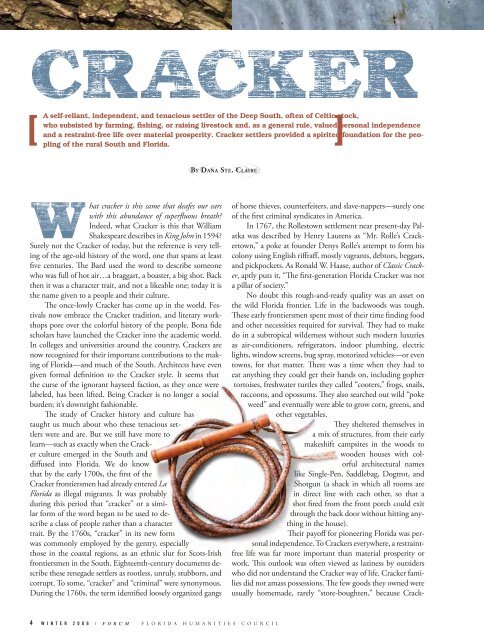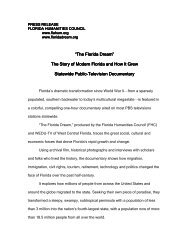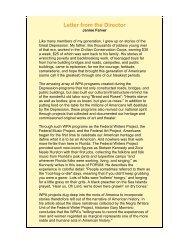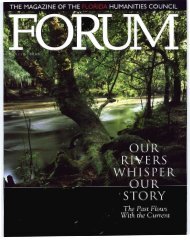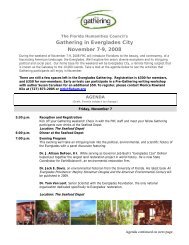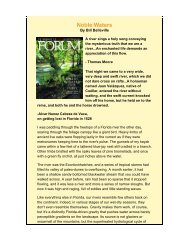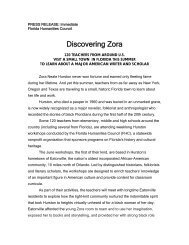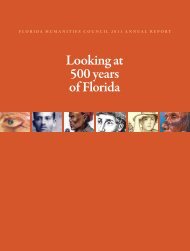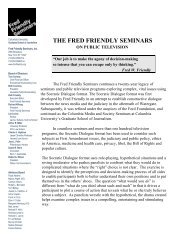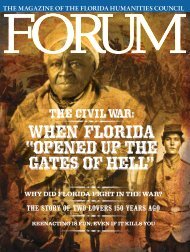THE MAGAZINE OF THE FLORIDA HUMANITIES COUNCIL
THE MAGAZINE OF THE FLORIDA HUMANITIES COUNCIL
THE MAGAZINE OF THE FLORIDA HUMANITIES COUNCIL
You also want an ePaper? Increase the reach of your titles
YUMPU automatically turns print PDFs into web optimized ePapers that Google loves.
[<br />
A self-reliant, independent, and tenacious settler of the Deep South, often of Celtic<br />
]<br />
stock,<br />
who subsisted by farming, fishing, or raising livestock and, as a general rule, valued personal independence<br />
and a restraint-free life over material prosperity. Cracker settlers provided a spirited foundation for the peopling<br />
of the rural South and Florida.<br />
What cracker is this same that deafes our ears<br />
with this abundance of superfluous breath?<br />
Indeed, what Cracker is this that William<br />
Shakespeare describes in King John in 1594?<br />
Surely not the Cracker of today, but the reference is very telling<br />
of the age-old history of the word, one that spans at least<br />
five centuries. The Bard used the word to describe someone<br />
who was full of hot air…a braggart, a boaster, a big shot. Back<br />
then it was a character trait, and not a likeable one; today it is<br />
the name given to a people and their culture.<br />
The once-lowly Cracker has come up in the world. Festivals<br />
now embrace the Cracker tradition, and literary workshops<br />
pore over the colorful history of the people. Bona fide<br />
scholars have launched the Cracker into the academic world.<br />
In colleges and universities around the country, Crackers are<br />
now recognized for their important contributions to the making<br />
of Florida—and much of the South. Architects have even<br />
given formal definition to the Cracker style. It seems that<br />
the curse of the ignorant hayseed faction, as they once were<br />
labeled, has been lifted. Being Cracker is no longer a social<br />
burden; it’s downright fashionable.<br />
The study of Cracker history and culture has<br />
taught us much about who these tenacious settlers<br />
were and are. But we still have more to<br />
learn—such as exactly when the Cracker<br />
culture emerged in the South and<br />
diffused into Florida. We do know<br />
that by the early 1700s, the first of the<br />
Cracker frontiersmen had already entered La<br />
Florida as illegal migrants. It was probably<br />
during this period that “cracker” or a similar<br />
form of the word began to be used to describe<br />
a class of people rather than a character<br />
trait. By the 1760s, “cracker” in its new form<br />
was commonly employed by the gentry, especially<br />
those in the coastal regions, as an ethnic slur for Scots-Irish<br />
frontiersmen in the South. Eighteenth-century documents describe<br />
these renegade settlers as rootless, unruly, stubborn, and<br />
corrupt. To some, “cracker” and “criminal” were synonymous.<br />
During the 1760s, the term identified loosely organized gangs<br />
By Dana Ste. Claire<br />
4 W I N T E R 2 0 0 6 / F O R U M F L O R I D A H U M A N I T I E S C O U N C I L<br />
of horse thieves, counterfeiters, and slave-nappers—surely one<br />
of the first criminal syndicates in America.<br />
In 1767, the Rollestown settlement near present-day Palatka<br />
was described by Henry Laurens as “Mr. Rolle’s Crackertown,”<br />
a poke at founder Denys Rolle’s attempt to form his<br />
colony using English riffraff, mostly vagrants, debtors, beggars,<br />
and pickpockets. As Ronald W. Haase, author of Classic Cracker,<br />
aptly puts it, “The first-generation Florida Cracker was not<br />
a pillar of society.”<br />
No doubt this rough-and-ready quality was an asset on<br />
the wild Florida frontier. Life in the backwoods was tough.<br />
These early frontiersmen spent most of their time finding food<br />
and other necessities required for survival. They had to make<br />
do in a subtropical wilderness without such modern luxuries<br />
as air-conditioners, refrigerators, indoor plumbing, electric<br />
lights, window screens, bug spray, motorized vehicles—or even<br />
towns, for that matter. There was a time when they had to<br />
eat anything they could get their hands on, including gopher<br />
tortoises, freshwater turtles they called “cooters,” frogs, snails,<br />
raccoons, and opossums. They also searched out wild “poke<br />
weed” and eventually were able to grow corn, greens, and<br />
other vegetables.<br />
They sheltered themselves in<br />
a mix of structures, from their early<br />
makeshift campsites in the woods to<br />
wooden houses with colorful<br />
architectural names<br />
like Single-Pen, Saddlebag, Dogtrot, and<br />
Shotgun (a shack in which all rooms are<br />
in direct line with each other, so that a<br />
shot fired from the front porch could exit<br />
through the back door without hitting anything<br />
in the house).<br />
Their payoff for pioneering Florida was personal<br />
independence. To Crackers everywhere, a restraintfree<br />
life was far more important than material prosperity or<br />
work. This outlook was often viewed as laziness by outsiders<br />
who did not understand the Cracker way of life. Cracker families<br />
did not amass possessions. The few goods they owned were<br />
usually homemade, rarely “store-boughten,” because Crack-


